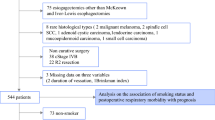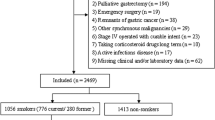Abstract
Background
Smoking is one of the risk factors for postoperative morbidity. There were no studies on the correlation between the duration of smoking cessation and the incidence of morbidities after esophagectomy.
Methods
A total of 246 patients undergoing elective esophagectomy with 2- or 3-field lymphadenectomy for esophageal cancer between April 2005 and February 2015 were retrospectively analyzed. Patients were divided into five groups according to the duration of smoking cessation [no smoking cessation (including cessation for a few days), cessation for 7–30, 31–90, ≥91 days, never smoker].
Results
Any morbidity of Clavien–Dindo classification (CDc) ≥II, pneumonia, any pulmonary morbidity, surgical site infection, cardiovascular morbidity, and severe morbidities of CDc ≥IIIb frequently occurred in patients with no smoking cessation. The incidence of pneumonia and severe morbidities decreased as the duration of smoking cessation became longer. Logistic regression analysis suggested that no smoking cessation was the independent risk factor for any pulmonary morbidity (HR 3.68, 95 % CI 1.152–11.74; p = 0.028). Smoking cessation ≤30 days was also the independent risk factor for pneumonia (HR 2.89, 95 % CI 1.141–7.301; p = 0.025). Smoking cessation ≤90 days was the independent risk factor for severe morbidities of CDc ≥IIIb (HR 2.82, 95 % CI 1.072–7.427; p = 0.036).
Conclusions
Preoperative smoking cessation more than 90 days is ideal to reduce morbidities after esophagectomy. When patients with insufficient smoking cessation undergo esophagectomy, careful perioperative management is required.
Similar content being viewed by others
References
Mantziari S, Hübner M, Demartines N, Schäfer M (2014) Impact of preoperative risk factors on morbidity after esophagectomy: is there room for improvement? World J Surg 38:2882–2890. doi:10.1007/s00268-014-2686-9
Takeuchi H, Miyata H, Gotoh M, Kitagawa Y, Baba H, Kimura W et al (2014) A risk model for esophagectomy using data of 5354 patients included in a Japanese nationwide web-based database. Ann Surg 260:259–266
Ferguson MK, Celauro AD, Prachand V (2011) Assessment of a scoring system for predicting complications after esophagectomy. Dis Esophagus 24:510–515
Dutta S, Al-Mrabt NM, Fullarton GM, Horgan PG, McMillan DC (2011) A Comparison of POSSUM and GPS models in the prediction of post-operative outcome in patients undergoing oesophago-gastric cancer resection. Ann Surg Oncol 18:2808–2817
Grotenhuis BA, van Hagen P, Reitsma JB, Lagarde SM, Wijnhoven BP, van Berge Henegouwen MI et al (2010) Validation of a nomogram predicting complications after esophagectomy for cancer. Ann Thorac Surg 90:920–925
Dhungel B, Diggs BS, Hunter JG, Sheppard BC, Vetto JT, Dolan JP (2010) Patient and peri-operative predictors of morbidity and mortality after esophagectomy: American College of Surgeons National Surgical Quality Improvement Program (ACS-NSQIP), 2005-2008. J Gastrointest Surg 14:1492–1501
Schieman C, Wigle DA, Deschamps C, Nichols Iii FC, Cassivi SD, Shen KR et al (2012) Patterns of operative mortality following esophagectomy. Dis Esophagus 25:645–651
Paul DJ, Jamieson GG, Watson DI, Devitt PG, Game PA (2011) Perioperative risk analysis for acute respiratory distress syndrome after elective oesophagectomy. ANZ J Surg 81:700–706
Ferguson MK, Celauro AD, Prachand V (2011) Prediction of major pulmonary complications after esophagectomy. Ann Thorac Surg 91:1494–1500
Zingg U, Smithers BM, Gotley DC, Smith G, Aly A, Clough A et al (2011) Factors associated with postoperative pulmonary morbidity after esophagectomy for cancer. Ann Surg Oncol 18:1460–1468
Yoshida N, Watanabe M, Baba Y, Iwagami S, Ishimoto T, Iwatsuki M et al (2014) Risk factors for pulmonary complications after esophagectomy for esophageal cancer. Surg Today 44:526–532
Shiozaki A, Fujiwara H, Okamura H, Murayama Y, Komatsu S, Kuriu Y et al (2012) Risk factors for postoperative respiratory complications following esophageal cancer resection. Oncol Lett 3:907–912
Law S, Wong KH, Kwok KF, Chu KM, Wong J (2004) Predictive factors for postoperative pulmonary complications and mortality after esophagectomy for cancer. Ann Surg 240:791–800
Edge SB, Byrd DR, Compton CC, Fritz AG, Greene FL, Trotti A (2009) AJCC cancer staging manual, 7th edn. Springer, New York
Society of Thoracic Surgeons (2013) Risk-adjusted morbidity and mortality for esophagectomy for cancer. http://www.sts.org/quality-research-patient-safety/quality/quality-performance-measures. Accessed 15 Mar 2015]
National Cancer Institute (2010) Common terminology criteria for adverse events (CTCAE). United States Department of Health and Human Services. http://evs.nci.nih.gov/ftp1/CTCAE/CTCAE_4.03_2010-06-14_QuickReference_5x7.pdf#search=‘http%3A%2F%2Fevs.nci.nih.gov%2Fftp1%2FCTCAE%2F+CTCAE_4.03_20100614_QuickReference_5x7.pdf. Accessed 15 Mar 2015]
Dindo D, Demartines N, Clavien PA (2004) Classification of surgical complications: a new proposal with evaluation in a cohort of 6336 patients and results of a survey. Ann Surg 240:205–213
Kojima S, Sakakibara H, Motani S, Hirose K, Mizuno F, Ochiai M et al (2007) Incidence of chronic obstructive pulmonary disease, and the relationship between age and smoking in a Japanese population. J Epidemiol 17:54–60
Benedetto U, Albanese A, Kattach H, Ruggiero D, De Robertis F, Amrani M et al (2014) Smoking cessation before coronary artery bypass grafting improves operative outcomes. J Thorac Cardiovasc Surg 148:468–474
Sepehripour AH, Lo TT, McCormack DJ, Shipolini AR (2012) Is there benefit in smoking cessation prior to cardiac surgery? Interact CardioVasc Thorac Surg 15:726–732
Barrera R, Shi W, Amar D, Thaler HT, Gabovich N, Bains MS et al (2005) Smoking and timing of cessation: impact on pulmonary complications after thoracotomy. Chest 127:1977–1983
Musallam KM, Rosendaal FR, Zaatari G, Soweid A, Hoballah JJ, Sfeir PM et al (2013) Smoking and the risk of mortality and vascular and respiratory events in patients undergoing major surgery. JAMA Surg 148:755–762
van Hagen P, Hulshof MC, van Lanschot JJ, Steyerberg EW, van Berge Henegouwen MI, Wijnhoven BP et al (2012) Preoperative chemoradiotherapy for esophageal or junctional cancer. N Engl J Med 366:2074–2084
Ando N, Kato H, Igaki H, Shinoda M, Ozawa S, Shimizu H et al (2012) A randomized trial comparing postoperative adjuvant chemotherapy with cisplatin and 5-fluorouracil versus preoperative chemotherapy for localized advanced squamous cell carcinoma of the thoracic esophagus (JCOG9907). Ann Surg Oncol 19:68–74
Akutsu Y, Matsubara H (2009) Perioperative management for the prevention of postoperative pneumonia with esophageal surgery. Ann Thorac Cardiovasc Surg 15:280–285
Findlay JM, Gillies RS, Millo J, Sgromo B, Marshall RE, Maynard ND (2014) Enhanced recovery for esophagectomy: a systematic review and evidence-based guidelines. Ann Surg 259:413–431
Biere SS, van Berge Henegouwen MI, Maas KW, Bonavina L, Rosman C, Garcia JR et al (2012) Minimally invasive versus open oesophagectomy for patients with oesophageal cancer: a multicentre, open-label, randomised controlled trial. Lancet 379:1887–1892
Author information
Authors and Affiliations
Corresponding author
Ethics declarations
Conflict of interest
None.
Rights and permissions
About this article
Cite this article
Yoshida, N., Baba, Y., Hiyoshi, Y. et al. Duration of Smoking Cessation and Postoperative Morbidity After Esophagectomy for Esophageal Cancer: How Long Should Patients Stop Smoking Before Surgery?. World J Surg 40, 142–147 (2016). https://doi.org/10.1007/s00268-015-3236-9
Published:
Issue Date:
DOI: https://doi.org/10.1007/s00268-015-3236-9




